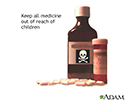Ethylene glycol poisoning
Intoxication - ethylene glycol
Ethylene glycol is a colorless, odorless, sweet-tasting chemical. It is poisonous if swallowed.
Ethylene glycol may be swallowed accidentally, or it may be taken deliberately in a suicide attempt or as a substitute for drinking alcohol (ethanol).
This article is for information only. Do NOT use it to treat or manage an actual poison exposure. If you or someone you are with has an exposure, call your local emergency number (such as 911), or your local poison center can be reached directly by calling the national toll-free Poison Help hotline (1-800-222-1222) from anywhere in the United States.
Causes
Ethylene glycol may be swallowed accidentally, or it may be taken deliberately in a suicide attempt or as a substitute for drinking alcohol (ethanol).
Ethylene glycol is found in many household products, including:
- Antifreeze
- De-icing products
- Detergents
- Paints
- Cosmetics
Note: This list may not be all-inclusive
Symptoms
The first symptom of ethylene glycol ingestion is similar to the feeling caused by drinking alcohol (ethanol). Within a few hours, more toxic effects become apparent. Symptoms may include nausea, vomiting, convulsions, stupor (decreased level of alertness), or even coma.
Ethylene glycol toxicity should be suspected in anyone who is severely ill after drinking an unknown substance, especially if they at first appear drunk and you can't smell alcohol on their breath.
An overdose of ethylene glycol can damage the brain, lungs, liver, and kidneys. The poisoning causes disturbances in the body's chemistry, including metabolic acidosis . The disturbances may be severe enough to cause profound shock , organ failure, and death.
Metabolic acidosis
Metabolic acidosis is a condition in which there is too much acid in the body fluids.

Shock
Shock is a life-threatening condition that occurs when the body is not getting enough blood flow. Lack of blood flow means that the cells and organs...

As little as 120 milliliters (approximately 4 fluid ounces) of ethylene glycol may be enough to kill an average-sized man.
Exams and Tests
The health care provider will measure and monitor the patient's vital signs, including temperature, pulse, breathing rate, and blood pressure.
Diagnosis of ethylene glycol toxicity is usually made through a combination of blood, urine, and other tests such as:
- Arterial blood gas analysis
- Chemistry panel and liver function studies
- Chest x-ray (shows fluids in the lungs)
- Complete blood count (CBC)
- CT scan (shows brain swelling)
- EKG (electrocardiogram, or heart tracing)
- Ethylene glycol test
- Ketones -- blood
- Osmolality
- Toxicology screen
- Urinalysis
Tests will show increased levels of ethylene glycol, blood chemical disturbances, and possible signs of kidney failure and muscle or liver damage.
Treatment
Most people with ethylene glycol poisoning need to be admitted to a hospital's intensive care unit (ICU) for close monitoring. A breathing machine (respirator) may be needed.
Those who recently swallowed the ethylene glycol may have their stomach pumped (suctioned). This can help remove some of the poison.
Other treatments may include:
- Activated charcoal
- Sodium bicarbonate solution given through a vein (IV) to reverse severe acidosis
- Antidotes that slow the formation of the poisonous by-products in the body
In severe cases, dialysis may be used to directly remove the ethylene glycol and other poisonous substances from the blood. Dialysis reduces the time needed for the body to remove the toxins. Dialysis is also needed by patients who develop severe kidney failure as a result of poisoning. It may be needed for many months and possibly years, afterward.
Outlook (Prognosis)
How well a person does depends on how quickly treatment is received, among other things. When treatment is delayed, this type of poisoning can be deadly.
Possible Complications
Complications may include:
- Brain and nerve damage
- Coma
- Death
- Kidney failure
- Shock
When to Contact a Medical Professional
Ethylene glycol ingestion is a medical emergency. If you suspect possible poisoning, seek emergency care right away. Do not wait for poisoning symptoms to develop.
Take the container with you to the hospital, if possible.
The following information is helpful for emergency assistance:
- The patient's age, weight, and condition
- The name of the product (ingredients and strengths if known)
- The time it was swallowed
- The amount swallowed
However, DO NOT delay calling for help if this information is not immediately available.
Your local poison center can be reached directly by calling the national toll-free Poison Help hotline (1-800-222-1222) from anywhere in the United States. This hotline number will let you talk to experts in poisoning. They will give you further instructions.
Local poison center
For a POISON EMERGENCY call:1-800-222-1222ANYWHERE IN THE UNITED STATESThis national hotline number will let you talk to experts in poisoning. This ...

This is a free and confidential service. All local poison control centers in the United States use this national number. You should call if you have any questions about poisoning or poison prevention. You can call 24 hours a day, 7 days a week.
Prevention
Keep substances that contain ethylene glycol out of the reach of children.
References
Ford MD. Clinical Toxicology . 1st ed. Philadelphia, PA: WB Saunders; 2001.
White SR. Toxic alcohols. In: Marx JA, Hockberger RS, Walls RM, et al, eds. Rosen's Emergency Medicine: Concepts and Clinical Practice . 8th ed. Philadelphia, PA: Elsevier Saunders; 2014:chap 155.
Review Date: 1/13/2015
Reviewed By: Jacob L. Heller, MD, MHA, Emergency Medicine, Virginia Mason Medical Center, Seattle, WA. Also reviewed by David Zieve, MD, MHA, Isla Ogilvie, PhD, and the A.D.A.M. Editorial team.

